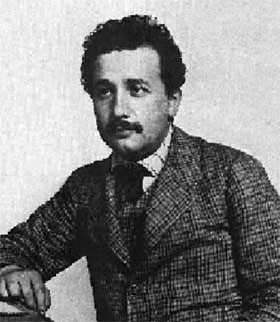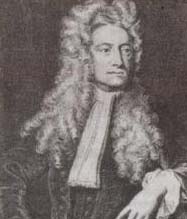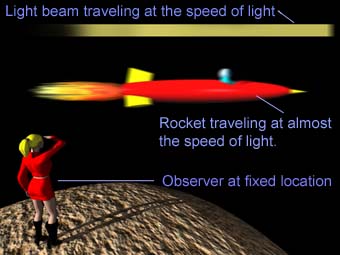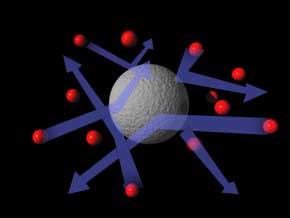Einstein
and the Universe

Einstein as
a clerk in the Swiss Patent Office.
|
Part
I: The Special Theory of Relativity
It's
been nearly a century since Einstein changed the universe with
his Special Theory of Relativity. His ideas rocked the physics
world and now we rank him alongside such great luminaries as Aristotle
and Newton. Who was this genius and how did he come upon his revolutionary
ideas?
Albert Einstein was born in
Ulm, Germany in 1879. His father, Hermann Einstein, had shown
an aptitude for mathematics as a boy, but became a businessman
because, as a Jew, he would not be provided a public university
education. Albert's mother, Pauline, had a passion for music,
something she would pass on to her son, through her insistence
on violin lessons. Young Albert resisted these, but as an adult,
often took to playing the fiddle as a way to relax as he pondered
the most difficult scientific problems.
It is said that as a boy Albert's
teachers found him slow, perhaps because he seemed to have difficulty
with learning by rote. He never gave his teachers a quick answer,
but hesitated, as if he was thinking about it. After giving an
answer, he would always repeat it softly to himself. This made
some of his teachers wonder if he was mentally retarded. Classmates
avoided him because he showed no interest in sports.
In Gymnasium, the German equivalent
of high-school, he had a terrible time with Greek. His teacher
was so frustrated with him he told young Albert "your mere
presence here undermines the class's respect for me." He
never graduated from that Gymnasium but left to join his family
when they moved to Italy.
As a high-school dropout,
Einstein had difficulty being accepted into college. His desire
was to study and teach philosophy,but no university would accept
him. His father, concerned about his son's financial future, pushed
Albert to go to a technical college. Iin 1895 he applied to the
Polytechnic Institute of Zurich, but he failed the entrance exam.
The college principal, noting that Einstein was almost two years
younger than most of the other candidates, decided to admit him
the following semester without making him retake the test.
At the Polytecnikum,
Albert was not considered the best of students. One professor
told him, "You're enthusiastic, but hopeless at physics.
For your own good you should switch to something else, medicine
or maybe literature or law." His math professor referred
to him as a "lazy dog." Another professor was antagonized
by him because he did not address him as "Herr Professor."
He barely passed the exit exam and was not offered a position
at the Institute as an assistant professor as he had hoped. Instead,
he had to settle for a job as a clerk at the Swiss patent office.
So how did this young man
with such an unpromising future in physics revolutionize the science?
As a boy he was a deep thinker. He had the ability to picture
a complex problem in simple terms. When he was sixteen he wondered
what a beam of light would look like if you rode a bicycle next
to it at the speed of light, or what his own image would look
like in the mirror at the speed of light. As he grew up, starting
with these seemingly simple questions and with a drive to understand
what he would later call "theories of principle", Einstein
found the answers that would overturn the physics world.
Scientists that worked with
Einstein noted he was neither a fast thinker nor the best of mathematicians.
What he had, though, was a passion to understand nature and little
interest in temporal goals. "I have never looked upon ease
and happiness as ends in themselves...The ordinary objects of
human endeaveor - property, outward success, luxury - have always
seemed to me contemptible," he wrote in 1934.
Einstein's "theories
of principle" were general rules that all phenomena must
satisfy. Throughout his work he persuaded these theories with
almost a moral fervor. He really cared, perhaps more than his
colleagues, that physics should explain nature consistently and
without contradiction.
The
19th Century: Physics in Crisis
|

Sir
Isaac Newton
|
Increasingly throughout the
19th century, scientists found themselves in a dilemma as long-held
principals came in conflict with new experimental data. In the
1400's Sir Isaac Newton had come up with a series of rules that
described the motion of bodies. Newton's Three Laws of Dynamics
were, by anybody's measure, a great success. Scientists could
use them to predict the motion of the planets in the sky as well
as the movement of more mundane objects back on Earth. One of
the rules that comes out of Newton's Laws, though, is that everything
is in motion relative to something else. Nothing in the universe
is absolutely still.
In the 19th century a brilliant
Scottish physicist named James Maxwell started studying electromagnetism.
His theories explained much that was observed in relation to the
movement of radiant energy waves such as light and x-rays.
Some of Maxwell's theories
directly contradicted Newton's Laws, however, and it seemed that
either Newton's Laws were wrong or Maxwell's theories. Einstein
likened the situation to a house built in two parts. The newly-added
wing was causing tensions in the whole structure and fissures
to appear in the masonry.
|

James
Maxwell
|
Maxwell had observed that
light, and other forms of radiant energy, moved like a wave, not
like a particle of matter. Waves, however, need a medium to move
through. Ocean waves move through water. Sound waves move through
air. What possible medium did light waves move through? Maxwell
called this supposed medium "ether." Since light travels
everywhere in the universe, it follows that the ether must extend
everywhere. Maxwell also stated that it had to be absolutely motionless.
This theory brought Maxwell's work into direct conflict with Newton's
Laws.
Another conflict in physics
was the problem of continuity. It was supposed (and later proven
by Einstein) that all matter was made of tiny particles. No object
is really solid but is composed of atoms separated by empty space.
This means that matter is not continuous, but discontinuous. Maxwell's
waves, however, appeared to be continuous. Since it was well known
that matter could produce light (for example, a burning candle)
physicists had a hard time explaining how discontinuous matter
could produce waves of continuous light.
Finally, confusing the issue
even further was an experiment done by Albert Michelson and Edward
Morley. They set out to prove the existence of ether by detecting
tiny differences in the speed of light. Their clever experiment
took a beam of light and split it two ways. One traveled along
the direction the earth traveled through space. The other traveled
across that same path. Later the two beams were allowed to combine
and create an interference pattern. If the edges of the pattern
were fuzzy, it meant that one of the split beams of light was
arriving just a bit later than the other. Michelson and Morley
expected that this would be the case as they thought one beam
should be reduced by the same amount of speed as the earth's forward
orbital movement.
The scientists were surprised
at the result of the experiment. It seemed that the speed of light
did not change even if one of the beams traveled the same direction
as the movement of the earth. What could this mean?
Einstein
Saves the Day
Perhaps mankind is lucky that
Einstein got turned down for a teaching job at the Polytecnikum.
As a professor his schedule would have been heavy. At the Swiss
patent office he worked during the day, but had ample time during
the night to ponder the problems of physics. In 1905 he submitted
four articles to the German Annalen der Physik (Annals
of Physics). They were published that year. Experts agree that
probably each of them was worthy of a Nobel prize. Many people
refer to 1905 as Einstein's "Miracle Year."
His first paper, which came
out in March, attacked the problem of discontinuity. Einstein
showed that light is actually made up of what he called "atoms
of energy" or "quanta" (these"quanta"
are now refered to as "photons.") Photons are the basic
unit of all forms of electromagnetic radiation. Einstein also
correctly hypothesized that photons have both properties of continuity
and discontinuity. They behave like a wave in some cases and like
a particle in others. This not only resolved a major problem in
science, but gave rise to a whole new field dealing with activity
in the world of particles smaller than the atom: quantum physics.
Special
Relativity
In June of 1905 Einstein's
second major paper was published which dealt with the nature of
the speed of light. He started his paper by declaring the idea
of an ether was "superfluous" and unnecessary to explain
what experiments were showing. Since light was a particle with
wave properties, it needed no medium. This is why Michelson and
Morley's experiment had failed. Since light was not a wave traveling
through a motionless "ether," the movement of the earth
was not subtracted from its speed. What the experiment showed
was that light is unique in that it always moves at the same speed
(approximately 186,000 miles per second, sometimes referred to
as the constant "c") no matter how fast the observer
is moving.
|

To
the observer the rocket seems to be traveling close to the
speed of light, but to the rocket pilot, because time slows
down for him, the light beam continues to move away from
him at the speed of light no matter how fast he accelerates.
|
This seemed to create a strange
contradiction. If a rocket pilot was traveling near the speed
of light - "c" - a motionless observer would see him
almost keeping up with a light beam traveling in the same direction.
Einstein said that if you asked the rocket pilot about the beam
of light, however, he would say that no matter how fast he accelerated
the beam was still traveling at speed "c" faster away
from him.
Einstein realized that the
only way this could happen was if time slowed down for the rocket
pilot as he accelerated to near the speed of light. Since his
clock would be running slower, when he measured the light beam
traveling next to him it would seem to be still moving at "c."
This idea that time did not have to be the same for all observers
in all places but is "relative" differs radically from
Newton's thinking and is the heart of the Special Theory.
Experiments have proven that
Einstein was right about time dilation of accelerated objects.
Today the GPS satellites that provide position information to
receivers on Earth must correct their onboard clocks by a tiny
amount to account for their speed as they orbit the planet. Time
moves just slightly faster for the satellites than it does down
here on Earth.
Not only does time change
as the result of acceleration, but physical objects get distorted
too. Yardsticks under Newton's laws were the same anywhere in
the universe under all conditions, but according to Einstein they
actually get shorter in the direction of travel as they are accelerated.
This isn't noticeable to the traveler, as everything around him,
including he and his spaceship, grows shorter also.
Since Einstein showed that
no "ether" was necessary to explain light, the contradiction
between Maxwell's work and Newton's Laws disappeared.
Almost as a postscript to
his theory, Einstein noted that matter was just a "condensed"
form of energy. The relationship is shown by his famous equation
"E=mc^2." Energy is equal to mass times the speed of
light squared. Since "c" is such a large number it follows
that if even a small bit of matter is converted, the amount of
energy released is enormous. This was demonstrated dramatically
with the first atomic bomb blasts. Only a tiny amount (.01 percent)
of the uranium in a bomb is converted to energy, but it accounts
for all the power unleashed in the explosion.
Brownian
Motion Explained
|

Brownian
motion is the random, jerky motions observed in floating
microscopic particles as they are bumped unevenly by the
surrounding atoms.
|
The other important paper
Einstein produced in 1905 explained an effect called "Brownian
Motion." Brownian motion is the random, jerky motions observed
in floating microscopic particles. Einstein demonstrated that
this was caused by atoms striking the particles in uneven amounts
from different directions. This proved that atoms existed (something
that some scientists continued to doubt even at the beginning
of the 20th century). By analyzing the movement of the particles,
he was also able to calculate the number of atoms in a particular
mass of element and how much each atom weighed.
Einstein's success in 1905
would bring him fame. In 1908 he left the patent office for a
university position first in Bern and later in Prague. In 1912
he was appointed a professor at the Polytecnikum, his alma
mater. This success might seem to be enough for any man for any
one lifetime, but Einstein had greater goals. In 1907 he would
start thinking about how we could extend this theory of relativity
not just to include motion, but the entire universe.
Continue
on to Part II

Copyright Lee Krystek
2004. All Rights Reserved.